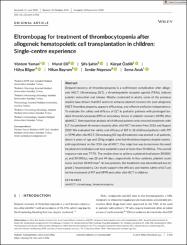Eltrombopag for treatment of thrombocytopenia after allogeneic hematopoietic cell transplantation in children: Single-centre experience

Göster/
Erişim
info:eu-repo/semantics/embargoedAccessTarih
2021Yazar
Yaman, YöntemElli, Murat
Şahin, Şifa
Özdilli, Kürşat
Bilgen, Hülya
Bayram, Nihan
Nepesov, Serdar
Anak, Sema
Üst veri
Tüm öğe kaydını gösterKünye
Yaman, Y., Elli, M., Şahin, Ş., Özdilli, K., Bilgen, H., Bayram, N. ... Anak, S. (2021). Eltrombopag for treatment of thrombocytopenia after allogeneic hematopoietic cell transplantation in children: Single-centre experience. Pediatric Transplantation, 25(5). https://dx.doi.org/10.1111/petr.13962Özet
Delayed recovery of thrombocytopenia is a well-known complication after allogeneic HSCT. Eltrombopag (ELT), a thrombopoietin receptor agonist (TRAs), induces platelet maturation and release. Mostly conducted in adults, some of the previous studies have shown that ELT seems to enhance platelet recovery for post-allogeneic HSCT thrombocytopenia, appears efficacious, and offers transfusion independence. To evaluate the safety and efficacy of ELT in pediatric patients with prolonged isolated thrombocytopenia (PIT) or secondary failure of platelet recovery (SFPR) after alloHSCT. Retrospective analysis of childhood patients who received treatment with ELT for persistent thrombocytopenia after alloHSCT between May 2016 and August 2019. We evaluated the safety and efficacy of ELT in 18 childhood patients with PIT or SFPR after alloHSCT. Eltrombopag (50 mg/d) treatment was started in all patients, above 6 years of age and 20 kg weight, who had thrombocytopenia despite neutrophil engraftment on the 30th day of HSCT. Our objective was to decrease the need for platelet transfusion and have a platelet count of more than 50 000/mu L. The overall response rate was 77.7%. The median time to achieve a platelet level above 30 000/mu L and 50 000/mu L was 21 and 44 days, respectively. In four patients, platelet count never reached 30 000/mm(3). In two patients, the treatment was discontinued due to grade 3 hepatotoxicity. Our study supports the efficacy and relative safety of ELT use for the treatment of PIT and SFPR seen after alloHSCT in children.
WoS Q Kategorisi
Q4Scopus Q Kategorisi
Q2Kaynak
Pediatric TransplantationCilt
25Sayı
5Koleksiyonlar
- Makale Koleksiyonu [3751]
- PubMed İndeksli Yayınlar Koleksiyonu [4203]
- Scopus İndeksli Yayınlar Koleksiyonu [6522]
- WoS İndeksli Yayınlar Koleksiyonu [6585]

















